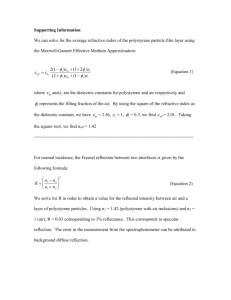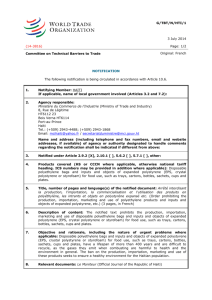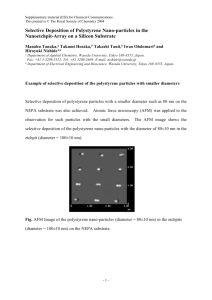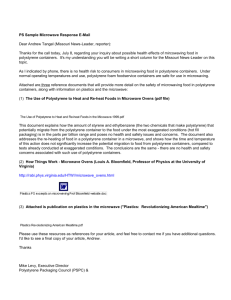Identification of Chromophores of Thermally Degraded Polystyrene
advertisement
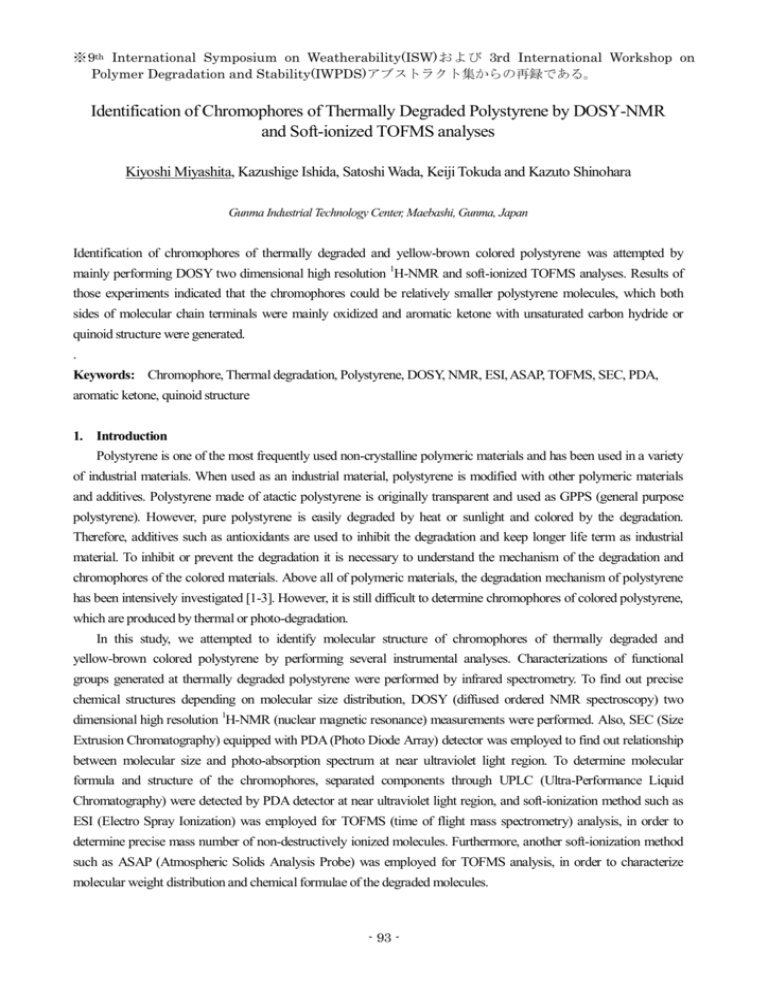
※9th International Symposium on Weatherability(ISW)および 3rd International Workshop on Polymer Degradation and Stability(IWPDS)アブストラクト集からの再録である。 Identification of Chromophores of Thermally Degraded Polystyrene by DOSY-NMR and Soft-ionized TOFMS analyses Kiyoshi Miyashita, Kazushige Ishida, Satoshi Wada, Keiji Tokuda and Kazuto Shinohara Gunma Industrial Technology Center, Maebashi, Gunma, Japan Identification of chromophores of thermally degraded and yellow-brown colored polystyrene was attempted by mainly performing DOSY two dimensional high resolution 1H-NMR and soft-ionized TOFMS analyses. Results of those experiments indicated that the chromophores could be relatively smaller polystyrene molecules, which both sides of molecular chain terminals were mainly oxidized and aromatic ketone with unsaturated carbon hydride or quinoid structure were generated. . Keywords: Chromophore, Thermal degradation, Polystyrene, DOSY, NMR, ESI, ASAP, TOFMS, SEC, PDA, aromatic ketone, quinoid structure 1. Introduction Polystyrene is one of the most frequently used non-crystalline polymeric materials and has been used in a variety of industrial materials. When used as an industrial material, polystyrene is modified with other polymeric materials and additives. Polystyrene made of atactic polystyrene is originally transparent and used as GPPS (general purpose polystyrene). However, pure polystyrene is easily degraded by heat or sunlight and colored by the degradation. Therefore, additives such as antioxidants are used to inhibit the degradation and keep longer life term as industrial material. To inhibit or prevent the degradation it is necessary to understand the mechanism of the degradation and chromophores of the colored materials. Above all of polymeric materials, the degradation mechanism of polystyrene has been intensively investigated [1-3]. However, it is still difficult to determine chromophores of colored polystyrene, which are produced by thermal or photo-degradation. In this study, we attempted to identify molecular structure of chromophores of thermally degraded and yellow-brown colored polystyrene by performing several instrumental analyses. Characterizations of functional groups generated at thermally degraded polystyrene were performed by infrared spectrometry. To find out precise chemical structures depending on molecular size distribution, DOSY (diffused ordered NMR spectroscopy) two dimensional high resolution 1H-NMR (nuclear magnetic resonance) measurements were performed. Also, SEC (Size Extrusion Chromatography) equipped with PDA (Photo Diode Array) detector was employed to find out relationship between molecular size and photo-absorption spectrum at near ultraviolet light region. To determine molecular formula and structure of the chromophores, separated components through UPLC (Ultra-Performance Liquid Chromatography) were detected by PDA detector at near ultraviolet light region, and soft-ionization method such as ESI (Electro Spray Ionization) was employed for TOFMS (time of flight mass spectrometry) analysis, in order to determine precise mass number of non-destructively ionized molecules. Furthermore, another soft-ionization method such as ASAP (Atmospheric Solids Analysis Probe) was employed for TOFMS analysis, in order to characterize molecular weight distribution and chemical formulae of the degraded molecules. - 93 - ※9th International Symposium on Weatherability(ISW)および 3rd International Workshop on Polymer Degradation and Stability(IWPDS)アブストラクト集からの再録である。 2. Experimental Materials Polystyrene used in this research was a mono-dispersive standard for SEC measurement with average molecular weight (Mw) of 860K and dispersion degree (Mw/Mn) of 1.16. Thermal treatment to the polystyrene was carried out to degrade and produced a yellow-brown color for 2h at 250℃ under atmospheric condition. Characterizations Infrared (IR) analyses were performed by a FTIR spectrometer Vertex70 equipped with an infrared microscopy Hyperion3000 (Bruker Optics) and ATR (Attenuated Total Reflectance)-IR spectra were obtained by an objective installed with a Germanium IRE (Internal Reflection Element) at wavenumber resolution of 8cm-1. DOSY two dimensional measurements were performed by a high resolution NMR spectrometer Avance500 (Bruker Biospin). Using a technique of pulse gradient magnetic field application, diffusion coefficients of molecules depending on molecular size of polystyrene, were obtained and dependence of 1H-NMR spectra with the diffusion coefficients was described in two dimensional figures. Samples for the measurements were dissolved with CDCl3. SEC measurements were performed by a SEC analysis system equipped with RI and PDA detectors (Shimazu) using a separation column of Shim-pack GPC-80M and elution of tetrahydrofuran. Samples were dissolved with tetrahydrofuran. Soft-ionized TOFMS analyses were performed by a TOFMS spectrometer LCT Premier XE (Waters). ESI was employed as a soft-ionization method and hyphenated with an UPLC system equipped with a PDA detector. Methanol was used to extract colored substance and elution for the system was water/methanol solution. Another soft-ionization method such as ASAP was employed, where heated nitrogen gas was sprayed onto the samples and ionized the thermally desorbed molecules by corona discharge and introduced to TOFMS spectrometer. 3. Results and discussion ATR-IR spectra of the original polystyrene and thermally treated polystyrene (a) are shown in Fig.1 with a subtraction spectrum of both spectra. From the spectra, it is considered that aromatic ketone (1684cm-1) and unsaturated carbon hydride (3025cm-1) (b) was generated and aliphatic carbon hydrate (3000~2800cm-1) eliminated by the thermal treatment. Also, changes of molecular (a) - (b) weights of the polystyrene by the thermal treatment could be expected from residues of the subtraction spectrum (1599, 1498, 1448, 693cm-1). Fig.1 ATR-IR spectra of the polystyrenes ((a) thermal treated,, (b) origin, (c) subtracted spectrum ((a) - (b)) - 94 - ※9th International Symposium on Weatherability(ISW)および 3rd International Workshop on Polymer Degradation and Stability(IWPDS)アブストラクト集からの再録である。 DOSY two dimensional figures with 1H-NMR spectra are shown in Fig.2. The figures indicates that comparatively small diffusion coefficients of the polystyrene (~ -11.3 log(m2/s)) were increased by the thermal treatment (-10.6 ~ -8.8 log(m2/s)). This result reveals that the molecular sizes of the polystyrene were significantly decreased. Also, DOSY figure of the thermal treated polystyrene shows that chemical shift of the 1H-NMR spectra increased at higher diffusion coefficients. This result indicate that smaller molecules generated by degradation due to the thermal treatment possessed more oxidized chemical environment around proton nuclei of the polystyrene, where aromatic proton (6.3~8.2ppm) possessed it more significantly compared to aliphatic proton (1.3~3.2ppm). Fig.2 DOSY two dimensional figures with 1H-NMR spectra of the polystyrenes (left: origin, right: thermal treated) Results of SEC measurements indicated that changes of molecular weight and distribution of the polystyrene caused by the thermal treatment corresponded to changes of diffusion coefficients obtained by DOSY measurements, and smaller molecules generated by the thermal treatment possessed light absorption at near ultraviolet light region, which could be one of chromophores of the yellow-brown colored polystyrene. UPLC-PDA-ESI-TOFMS results obtained from methanol extraction of the thermal treated polystyrene are shown in Fig.3. The UPLC chromatogram detected at near ultraviolet light region (350~400nm) shows some separation components and a component assigned as ② possesses TIC (Total Ion Current) detective signals. The positive ESI-TOFMS spectra of the ② component reveals two main positively ionized molecules of m/z=455.206 and 887.4161, which correspond to (C31H28O2)Na+ and (C31H28O2)2Na+ . This results indicate that molecular formula of component ② is C31H28O2 and the molecule was accompanied by Na+ addition and the latter was a dimer molecule caused by inter molecular association during ESI process. Then, molecular structure of the component is suggested as mainly O=(C8H6)(C8H8)2(C7H6)=O, where C8H8 is considered as styrene and both sides of molecular terminals were oxidized to produce aromatic ketone with unsaturated carbon hydride or qunoid structure. - 95 - ※9th International Symposium on Weatherability(ISW)および 3rd International Workshop on Polymer Degradation and Stability(IWPDS)アブストラクト集からの再録である。 350-400nm detection ② 210-300nm detection ② TIC Time/min m/z Fig3 UPLC-PDA chromatogram and TIC of ESI-TOFMS obtained from the thermally treated polystyrene (left) and positively ionized ESI-TOFMS spectra of separation component ② (right). + (BHT)H ○[O=(C8H6)(C8H8)n(C7H6)=O]H + m/z Fig.4 Positively ionized ASAP-TOFMS spectra of the polystyrenes ((a) origin, (b) thermal treated) - 96 - ※9th International Symposium on Weatherability(ISW)および 3rd International Workshop on Polymer Degradation and Stability(IWPDS)アブストラクト集からの再録である。 Results of ASAP-TOFMS measurements are shown in Fig.4. The positive ASAP-TOFMS spectra obtained from the thermal treated polystyrene exhibited significantly a large number of ionized small molecules ranging from m/z = ca.100 to 1700 and the main ionized molecules have an interval of m/z=104.038 with the nearest neighbors, which is equivalent molecular weight of styrene (C8H8). Also, precise TOFMS analysis exhibited the main ionized molecules assigned by ○ were determine as O=(C8H6)(C8H8)n(C7H6)=O accompanied by H+ addition during ASAP process. From these results, it was figured out that the degraded polystyrene produces small molecules, which both sides of the molecular chain terminals were mostly oxidized to possess aromatic ketone with unsaturated carbon hydrate or quinoid structure. That kind of oxidized polystyrene could be chromophores of the yellow-brown colored polystyrene and the smaller molecule could absorb near ultraviolet light or visible light more due to higher conjugated structure. 4. Conclusions By performing DOSY and soft-ionized TOFMS analyses in addition to IR and SEC, we concluded that the degraded polystyrene possess small molecules, of which both sides of molecular chain terminals were oxidized. Both oxidized terminals possessed aromatic ketones with unsaturated carbon hydride or qunoid structure. The smaller oxidized molecules could be the chromophores of the thermally degraded colored polystyrene. Reference [1] B. Ranby, J. F. Rabeck, “Photodegradation, Photooxodation and Photostabilization of Polymers”, John Wiley & Sons (1975). [2] I. C. McNeill, L. P. Razumovskii, V. M. Goldberg, G. E. zaikov, Polymer Degradation and Stability, 45, 1(1994)47. [3] M. Yang, Y. Shibasaki, J. Polymer Science PartA: Polymer Chemistry, 36, 13(1998)2315. - 97 -
